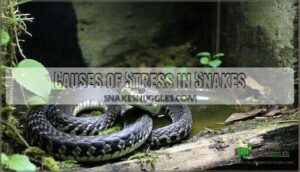This site is supported by our readers. We may earn a commission, at no cost to you, if you purchase through links.
 If my snake is stressed, you’ll notice key warning signs like refusing food, excessive hiding, or defensive behaviors such as hissing and striking.
If my snake is stressed, you’ll notice key warning signs like refusing food, excessive hiding, or defensive behaviors such as hissing and striking.
Temperature imbalances, inadequate hiding spots, or improper humidity levels often trigger stress responses in snakes.
Your snake needs stable environmental conditions with proper heat gradients, secure hiding places, and minimal disturbances to feel safe.
Quick relief involves checking your enclosure setup, ensuring proper temperatures, and reducing handling temporarily to promote healthy behavior.
Understanding these stress indicators helps you create a comfortable environment that prevents long-term health issues that can develop from chronic stress.
Table Of Contents
- Key Takeaways
- Recognizing Stress in Snakes
- Causes of Stress in Snakes
- Effects of Stress on Snakes
- How to Calm a Stressed Snake
- Handling Stressed Snakes With Care
- Addressing Long-Term Stress in Snakes
- Frequently Asked Questions (FAQs)
- Do snakes experience stress?
- How do I know if my pet snake is stressed?
- What are the symptoms of stress in snakes?
- Is your snake a sign of anxiety?
- Can stress cause a snake to die early?
- How do you deal with snake stress?
- How can you tell if a snake is stressed?
- How to tell if a snake is suffering?
- How does stress affect snakes?
- How to calm a stressed snake?
- Conclusion
Key Takeaways
- Watch for key stress signs – You’ll notice refusal to eat, excessive hiding, hissing, striking, or escape attempts when your snake’s feeling overwhelmed by environmental issues.
- Check your enclosure setup immediately – Verify that temperature gradients stay between 75-85°F, humidity levels remain at 40-60%, and you’ve provided at least two secure hiding spots.
- Reduce handling during stress periods – Stop handling your snake temporarily and avoid disturbing them during feeding or shedding cycles to prevent making stress worse.
- Address chronic stress quickly – Long-term stress weakens your snake’s immune system and can lead to serious health problems, like infections, so do not wait to make environmental improvements.
Recognizing Stress in Snakes
You’ll know your snake is stressed when it shows clear behavioral and physical changes that signal distress.
Understanding these warning signs helps you act quickly to restore your pet’s comfort and health.
Changes in Feeding Behavior
A snake’s feeding behavior serves as your first warning system when stress strikes. Refusal to eat stands as the most common red flag, especially when your snake skips multiple meals outside of natural brumation periods.
Your snake’s appetite serves as nature’s stress alarm—when meals get skipped, something’s wrong.
Monitor these critical feeding patterns:
- Loss of appetite that persists beyond normal seasonal changes
- Decreased appetite with longer intervals between accepted meals
- Food aversion where your snake approaches but ultimately rejects prey
Environmental factors often trigger these feeding issues. Temperature fluctuations, humidity imbalances, or habitat disruptions can create digestion stress that manifests as eating habits changes. Your snake’s feeding frequency may become erratic, signaling underlying discomfort that requires immediate attention.
Changes in Hiding and Escape Behaviors
Watch for dramatic shifts in your snake’s hiding behavior and escape attempts.
Stressed snakes either hide constantly or frantically seek escape routes, pacing enclosure walls.
These stress indicators signal environmental problems or inadequate tank security.
| Normal Behavior | Stress Signals |
|---|---|
| Uses multiple hiding spots | Stays in one hide constantly |
| Explores enclosure calmly | Paces walls seeking escape |
| Emerges during active hours | Refuses to leave hiding spots |
| Comfortable in open areas | Avoids exposed spaces entirely |
| Relaxed body posture | Tense, coiled defensive behavior |
Environmental triggers like loud noises, improper lighting, or insufficient snake hiding spots create these anxious responses.
Your pet’s snake behavior reflects its comfort level with current conditions.
Physical Symptoms to Observe
Physical symptoms tell the story your snake can’t speak.
Your snake’s body language reveals stress before words ever could.
Watch for these warning signs that indicate stress-related health issues:
- Weight loss from refusing meals or poor digestion
- Shedding problems like stuck skin or incomplete sheds
- Tail vibrating or rapid tail movements as defensive signals
- Heavy breathing or increased respiratory rate beyond normal
- Regurgitation after handling or environmental changes
These physical manifestations often accompany behavioral changes and require immediate attention to prevent long-term health complications.
Recognizing stress symptom patterns is essential for providing the right care and environment for your snake.
Common Signs of Stress
Beyond physical symptoms, you’ll notice key behavioral changes that signal trouble.
Your snake’s stress indicators become more obvious when you know what to watch for.
| Stress Sign | What to Look For |
|---|---|
| Nose Rubbing | Redness, swelling, or discharge around the nose |
| Tail Rattling | Rapid, loud vibrating of the tail |
| Appetite Loss | Refusing multiple meals consistently |
| Defensive Postures | Hissing, striking, or excessive coiling |
| Movement Changes | Frantic escaping attempts or unusual lethargy |
These snake stress signs often appear together, making recognizing snake stress easier once you understand the patterns.
Causes of Stress in Snakes
Understanding what causes stress in your snake is the first step toward helping them feel secure and healthy again.
Common stressors include improper environmental conditions, inadequate enclosure setup, and housing multiple snakes together, which can all contribute to making your snake feel insecure.
Environmental Factors Affecting Stress
Your snake’s environment can make or break their stress levels. Poor enclosure design affects temperature regulation and creates anxiety.
Here’s what impacts your snake’s comfort:
- Tank Temperature: Incorrect gradients between 75-85°F cause escape attempts and defensive behaviors
- Humidity Levels: Imbalances between 40-60% lead to dehydration and shedding problems
- Lighting Effects: Harsh exposure without hiding spots disrupts natural patterns
Noise pollution from vibrations also triggers stress responses.
Monitor these environmental factors closely to prevent stress indicators from developing. Proper reptile care techniques can help minimize stress in snakes.
Enclosure Size and Lack of Hiding Spots
Your snake’s Tank Size directly impacts stress levels.
Too small means constant confinement stress, while oversized spaces create anxiety from feeling exposed.
Most snakes need enclosures matching their length plus width for proper Space Requirements.
Hiding Places are non-negotiable for snake mental health.
Without adequate Hiding Spots, your snake experiences chronic stress from feeling vulnerable.
You need at least two hides—one on the warm side, one on the cool side of the enclosure.
This simple Enclosure Design rule prevents most environmental stressors.
Natural Snake Habitat includes multiple retreat options.
Wild snakes constantly seek cover from predators and harsh conditions.
Your captive snake retains these instincts, making proper habitat conditions with varied hiding options critical for wellbeing.
Poor enclosure size and insufficient hiding spots create a perfect storm of stress indicators including constant escape attempts and defensive behaviors.
Temperature and Humidity Imbalance
Why does improper thermoregulation wreak havoc on your snake’s well-being? Temperature and humidity imbalances create a domino effect of stress responses that compromise your pet’s health and comfort.
- Temperature gradients between 75-85°F allow proper snake temperature control for metabolic functions
- Humidity control at 40-60% prevents respiratory issues and shedding problems
- Heat sources with thermostats guarantee consistent snake temperature and humidity monitoring
Multiple Snakes in One Enclosure
Instead of cramming multiple snakes together, give each their own space. Snake Socialization doesn’t exist – these reptiles are solitary by nature.
Enclosure Sharing creates territorial disputes and increases stress causes. Multi Snake Care requires separate tanks to prevent disease transmission and aggressive behaviors.
| Housing Issue | Stress Impact | Solution |
|---|---|---|
| Territory disputes | High aggression | Separate enclosures |
| Disease transmission | Weakened immunity | Individual tanks |
| Food competition | Feeding stress | Solo feeding spaces |
| Species Compatibility conflicts | Behavioral changes | Research before pairing |
| Limited hiding spots | Increased anxiety | Multiple Tank Mates areas |
Effects of Stress on Snakes
When your snake experiences chronic stress, the effects go far beyond simple behavioral changes.
Prolonged stress weakens your pet’s immune system and can trigger serious health complications that require immediate veterinary attention.
Physical Manifestations of Stress
When stress signals appear in your snake, you’ll notice distinct physical symptoms that demand immediate attention.
These stress indicators affect your pet’s body in measurable ways.
Watch for these key physical symptoms:
- Weight loss from reduced appetite and metabolic changes
- Skin issues including poor shed cycles and discoloration
- Respiratory rate changes with rapid or labored breathing
- Shedding problems like stuck skin or incomplete sheds
These stress symptoms often compound each other, creating a cycle where physical discomfort increases anxiety levels in your snake.
Weakened Immune System
Your snake’s immune system weakens under stress, leaving it vulnerable to snake infections and stress induced illness.
Chronic disease becomes more likely as weakened defenses can’t fight off pathogens effectively.
This immune system failure creates a domino effect of stress related health issues.
Understanding snake health issues is essential for identifying potential problems.
| Stress Level | Immune Response | Health Risk |
|---|---|---|
| Mild | Slightly reduced | Minor infections |
| Moderate | Markedly impaired | Respiratory issues |
| Severe | Critically compromised | Septicemia risk |
| Chronic | Complete suppression | Life-threatening illness |
Stress impacts on health through elevated stress hormones that suppress white blood cell function, making your snake a sitting duck for snake health problems.
Refusal to Eat and Digestion Issues
When your snake consistently skips meals, feeding refusal signals serious distress.
Appetite loss often accompanies digestion problems like regurgitation and weight loss.
These eating disorders create a dangerous cycle—stress triggers gut issues, which worsen the underlying anxiety.
Monitor feeding patterns closely, as refusal to eat can quickly escalate into life-threatening malnutrition requiring immediate intervention.
Septicemia and Other Health Problems
Beyond digestion problems, chronic stress opens the door to serious Health Risks including Snake Septicemia and other stress-related illnesses.
When your snake’s immune system weakens, bacteria can enter through small wounds, causing abscesses and bloodstream infections. Infection Control becomes harder as stressed snakes can’t fight off pathogens effectively.
Watch for swelling, discoloration, or unusual behavior changes. Disease Prevention starts with reducing stress factors in your snake’s environment.
Veterinary Care is necessary when you notice signs of snake health issues, as untreated infections can become life-threatening. Early intervention substantially improves outcomes for infection risk management.
How to Calm a Stressed Snake
Once you’ve identified that your snake is stressed, creating the right environment becomes your top priority for their recovery.
The key is addressing the specific environmental factors that triggered the stress response in the first place, which is crucial for their recovery.
Providing a Suitable Environment
Create the perfect snake environment by ensuring proper enclosure size and temperature gradients between 75-85°F.
Maintain humidity levels at 40-60% depending on your species. Check that substrate depth allows natural burrowing behavior.
Remove stress triggers like excessive noise or vibrations. Proper tank setup with environmental enrichment helps your snake feel secure and comfortable.
A well-designed snake enclosure is essential for mimicking the snake’s natural habitat and promoting its overall well-being.
Offering Cover and Enrichment
Quality hiding places and environmental enrichment transform stressed snakes into confident companions.
Your snake needs visual barriers to feel secure and opportunities for natural behaviors.
- Snake hides in warm and cool zones provide temperature choice
- Tank decor like cork bark and artificial caves offer variety
- Environmental enrichment through climbing branches stimulates exploration
- Habitat modification with varied textures enhances sensory experiences
- Hiding spots should be snug and secure for maximum comfort
Providing proper snake hides and skins is essential for creating a comfortable environment.
Using Appropriate Burrowing Substrate
The right burrowing substrate helps your snake feel secure and reduces stress naturally.
Proper substrate choice creates essential hiding spots while supporting your snake’s digging behavior.
Key Burrowing Materials:
- Aspen shavings – excellent for natural digging behavior and humidity control
- Cypress mulch – maintains soil quality and moisture levels effectively
- Coconut fiber – provides soft texture for comfortable burrowing
- Paper towels – safe, clean option for easy enclosure maintenance
Maintain substrate depth of 3-4 inches for ideal enrichment opportunities.
Providing Climbing Opportunities
For arboreal snakes, vertical space transforms your enclosure into a climbing enrichment paradise.
Install sturdy branches at varying heights with different climbing textures like cork bark or natural wood.
Strategic branch placement creates multiple levels, encouraging natural behaviors.
These climbing structures provide essential arboreal enrichment, reducing stress through exploration.
Your snake habitat becomes dynamic with enrichment opportunities that promote physical activity and mental stimulation.
Handling Stressed Snakes With Care
When your snake shows stress signs, proper handling becomes essential for their recovery and your safety.
You’ll need to adjust your approach, timing, and technique to avoid making the situation worse while building trust over time, which is crucial for their well-being and your safety, emphasizing the importance of proper handling.
Handle Regularly to Build Trust
Once you’ve optimized your snake’s environment, regular handling becomes your most powerful tool for stress prevention. Gentle handling sessions help your snake develop trust building through consistent, positive interactions. Start with brief 5-10 minute sessions and gradually increase duration as your snake shows comfort. Regular interaction prevents defensive behaviors and promotes snake socialization.
Calm approach techniques for effective handling tips:
- Move slowly and deliberately to avoid startling your snake
- Support the snake’s body fully during handling sessions
- Begin with short daily sessions for ideal snake trust building
- Observe body language to gauge comfort levels during interaction
- Allow your snake to explore and tongue-flick during snake handling and bonding
This consistent routine transforms handling from a stressful event into a natural part of your snake’s life. Patient, frequent interaction creates lasting bonds while supporting overall stress prevention and reducing snake stress and anxiety. Understanding safe handling techniques is vital for minimizing stress and promoting a healthy relationship with your pet snake.
Avoid Handling Before Shedding or Feeding
Why wait for disaster when timing prevents it? Pre shedding care and proper feeding schedules are essential for stress reduction.
Never handle your snake during shedding or within 24-72 hours after feeding. These handling practices prevent regurgitation and reduce snake stress.
Your stressed pet snake needs undisturbed digestion time. Snake shedding stress increases when disturbed.
Allow complete snake acclimation to these natural processes before resuming handling techniques.
Get Your Snake Used to Your Presence
Snake socialization begins with letting your snake explore your scent through gentle, passive contact.
Allow tongue flicks and slow movement as positive trust building signals.
Keep initial human interaction sessions brief—5-10 minutes maximum.
Use consistent calming techniques like slow movements and quiet voices.
Regular, patient handling builds comfort over time, establishing essential foundations for stress-free snake handling and care.
Avoid Restraint and Overhandling
Restraint and overhandling worsen stress in snakes.
Limit handling sessions to short, gentle interactions. Watch for signs like tensing, hissing, or escape attempts—these indicate your snake needs space.
Proper handling techniques focus on support rather than control. Avoid grabbing or restraining movements.
Let your snake move naturally across your hands. This approach reduces stress and builds trust over time, promoting a healthier environment through gentle interactions.
Addressing Long-Term Stress in Snakes
Long-term stress management requires consistent environmental improvements and ongoing monitoring of your snake’s well-being.
You’ll need to implement permanent changes to your snake’s habitat while tracking behavioral patterns to guarantee lasting stress reduction.
Providing at Least Two Hides
Two hides aren’t optional – they’re your snake’s stress-busting necessities. Your snake needs secure hiding spots for ideal stress reduction and snake security.
Place hides strategically to create a comfortable snake habitat:
- Position one hide on the warm side for thermoregulation
- Place another on the cool side for temperature options
- Size hides snugly – your snake should fit comfortably inside
- Use natural materials like cork bark for authentic environmental enrichment.
Providing the right snake housing hides, such as proper ventilation systems, is vital for maintaining a healthy environment.
Choosing a Wooden Enclosure
Glass tanks make your snake feel exposed and vulnerable.
Wooden enclosure types provide superior humidity control and insulation compared to standard enclosure materials. Choose untreated woods like aspen for your snake enclosure setup.
Proper ventilation systems prevent mold while maintaining ideal habitat conditions. Wood creates a secure environment that reduces stress-related behaviors in your snake habitat.
When designing a snake’s home, consider the importance of suitable wooden snake enclosures.
Offering Variety and Stimulation
Environmental enrichment transforms your snake’s world into a dynamic, stress-free environment.
Rotate climbing branches, vary substrate textures, and introduce new scents for sensory stimulation.
Create exploration activities by hiding food or changing décor weekly, which provides visual interest while reducing environmental stress.
These enrichment strategies make hiding spots more appealing and engaging for ideal snake well-being, and are essential for creating a stimulating environment that reduces environmental stress.
Monitoring Your Snake’s Health and Happiness
Regular snake health monitoring helps you spot stress recognition early and maintain your pet’s well-being.
Watch for snake behavior changes like altered appetite, unusual hiding patterns, or physical symptoms that signal underlying issues. Snake stress signs often appear gradually, making consistent observation essential for effective stress management.
Here are three key indicators of a healthy, happy snake:
- Complete shed cycles: Your snake should shed its skin in one piece, indicating proper humidity levels and good health.
- Active exploration behavior: A content snake displays curiosity about its environment, tongue-flicking regularly, and moving confidently through its enclosure during active periods.
- Consistent feeding response: Healthy snakes maintain regular eating schedules and show interest in food.
Proper snake nutrition supports overall health, while feeding refusal often indicates stress or illness requiring immediate attention through health checks and environmental enrichment adjustments.
Frequently Asked Questions (FAQs)
Do snakes experience stress?
Yes, snakes absolutely experience stress – it’s their body’s natural response to challenging situations.
You’ll notice behavioral changes like loss of appetite, excessive hiding, hissing, or striking when they’re overwhelmed by environmental factors or improper handling.
How do I know if my pet snake is stressed?
Watch for loss of appetite, hissing, striking, escape attempts, tail rattling, nose rubbing, regurgitation, flinching when touched, defecating during handling, and heavy breathing patterns.
What are the symptoms of stress in snakes?
Look for loss of appetite, hissing, striking, escape attempts, tail rattling, nose rubbing, regurgitation, excessive hiding, and defensive coiling. These behaviors signal your snake needs environmental adjustments or handling changes.
Is your snake a sign of anxiety?
Your snake isn’t inherently a sign of anxiety, but stressed snakes display clear behavioral changes.
Watch for hissing, striking, excessive hiding, appetite loss, and escape attempts—these indicate your pet needs environmental adjustments or veterinary care to address the anxiety.
Can stress cause a snake to die early?
Chronic stress absolutely can shorten your snake’s lifespan. It weakens their immune system, making them vulnerable to infections and diseases that healthy snakes would normally fight off successfully.
How do you deal with snake stress?
Like a coiled spring slowly releasing tension, stressed snakes need environmental adjustments first.
Check temperature, humidity, and hiding spots. Reduce handling frequency.
Maintain consistent routines. Most stress resolves with proper habitat conditions, leading to a more stable and calm state, especially when the habitat is well-adjusted.
How can you tell if a snake is stressed?
Watch for behavioral changes like loss of appetite, excessive hiding, hissing, striking, or escape attempts.
You’ll also notice physical signs such as nose rubbing, regurgitation, or abnormal shedding patterns indicating stress.
How to tell if a snake is suffering?
Signs of a suffering snake appear like warning bells—watch for prolonged lethargy, complete appetite loss, labored breathing, dramatic weight loss, constant hiding, abnormal shedding, and repeated self-injury behaviors against enclosure walls.
How does stress affect snakes?
Stress weakens your snake’s immune system, disrupts eating and shedding cycles, causes weight loss, and triggers defensive behaviors like hissing and striking. It makes them vulnerable to illness.
How to calm a stressed snake?
First, check your snake’s environment immediately. Adjust temperature and humidity to species-appropriate levels. Provide adequate hiding spots, minimize handling, and maintain a quiet, stable environment for recovery.
Conclusion
Like a canary in a coal mine, your snake’s behavior signals environmental dangers before they become critical.
When my snake is stressed, swift action prevents serious health complications.
Check temperature gradients, humidity levels, and hiding spots immediately.
Reduce handling frequency and minimize enclosure disturbances.
Monitor feeding responses and physical symptoms closely.
These proactive measures restore your snake’s comfort and prevent chronic stress from weakening their immune system permanently.
- https://www.livescience.com/57361-stressed-snakes-more-likely-to-strike.html
- https://aminoapps.com/c/reptiles/page/item/stress-in-ball-pythons-and-how-to-prevent-it/z6gj_gV4hwIY6r14EBL6pJzZDDrvoZ8kJ73
- https://redinational.com/can-weather-conditions-affect-snake-activity-in-your-area/
- https://openjournals.ugent.be/vdt/article/id/75816/
- https://pmc.ncbi.nlm.nih.gov/articles/PMC9928108/


















